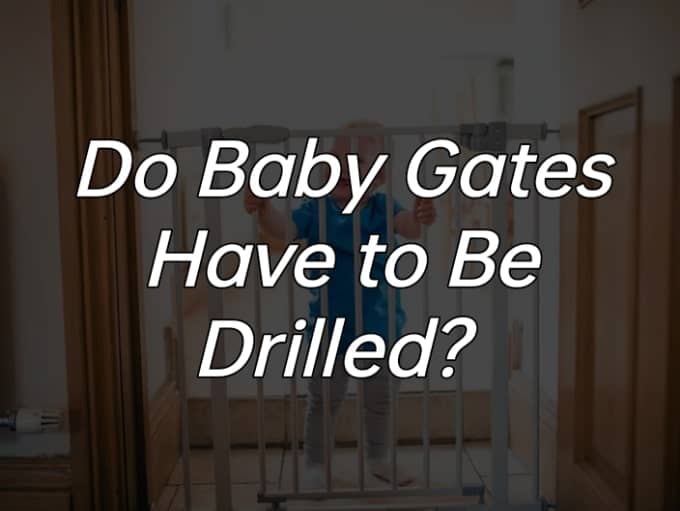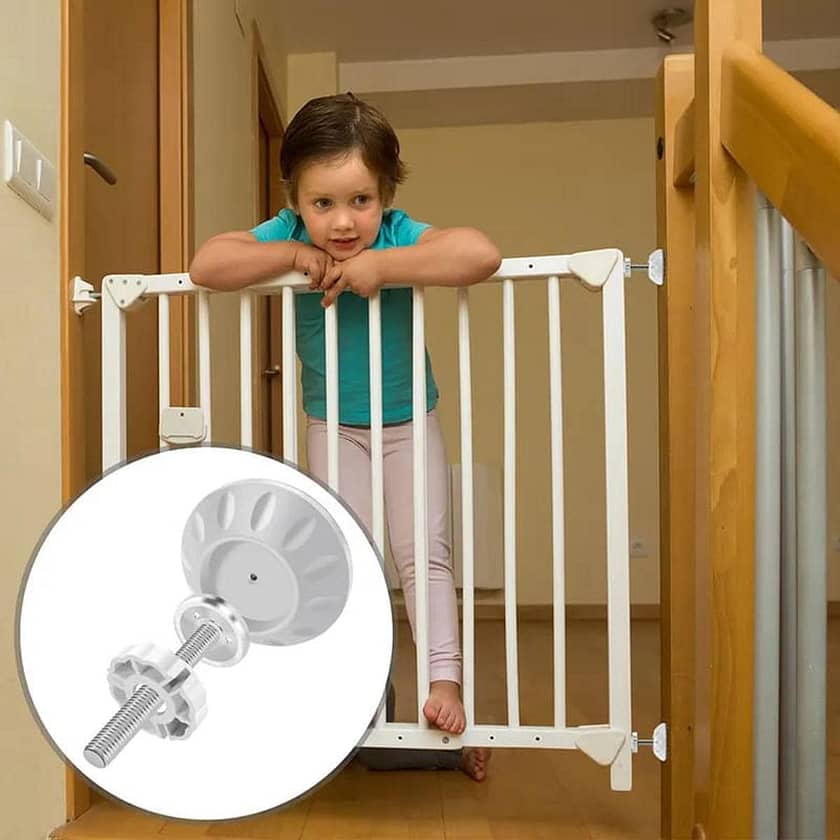Table of Contents
ToggleWhether you’re a new parent child-proofing your home or a grandparent preparing for those treasured visits, safety is paramount. One question on the minds of many is, “Do baby gates have to be drilled?”
This common inquiry stems from the desire to balance safety, convenience, and home aesthetics. Read on as we explore this topic further, providing valuable insights for your family’s safety.
Overview do baby gates have to be drilled?
Baby gates, also known as child safety gates, are a crucial tool for ensuring a child’s safety in the home.
While many parents and guardians may worry about the necessity of drilling into walls or banisters to secure these gates, rest assured that it’s not always compulsory.
The choice between drill and no-drill options largely depends on your specific needs, the layout of your home, and personal preferences. We’ll dive deeper into these considerations in the following sections.

Advantages and Disadvantages of Drilling in a Baby Gate:
Advantages of Drilling in a Baby Gate:
Drilling to install baby gates generally allows for a more robust and secure fit. These gates are less likely to be dislodged accidentally, providing greater peace of mind regarding your child’s safety. Also, these gates typically swing open like a door, which can be more convenient for parents and caregivers navigating around the house with their hands full.
Disadvantages of Drilling in a Baby Gate:
On the downside, drilling for baby gate installation involves making permanent holes in your walls, staircases, or doorframes, which could affect the aesthetics of your home. It could also pose problems if you’re renting or have historical or delicate trim work. Furthermore, relocating the gate can be challenging once it’s drilled into place, limiting flexibility if your needs change over time.
Advantages and Disadvantages of Non-Drilled Baby Gate Installations:
Advantages of Non-Drilled Baby Gates:
- Ease of Installation: Non-drilled baby gates are typically easy to install and don’t require any special tools or skills. You can set them up quickly without much hassle.
- Flexibility: If you need to move the gate to a different location, non-drilled gates offer greater flexibility. They can be easily relocated without causing any damage to your home.
- No Damage: Since no drilling is required, these gates will not cause any permanent holes or damage to your walls or doorframes, maintaining the aesthetics and integrity of your home.
Disadvantages of Non-Drilled Baby Gates:
- Less Secure: Without being anchored into the wall, non-drilled gates may be less secure. They might not stand up to a strong push or pull from an adventurous toddler.
- Potential for Toppling: Non-drilled gates rely on pressure points to stay in place. If not installed correctly, they could potentially topple over.
- Limited Design Options: Often, design options for non-drilled gates are more limited, as they need to cater to a broad range of door and stair widths.
Ways to Avoid Drilling When Installing a Baby Gate
Using Pressure-Mounted Gates
Pressure-mounted gates are a great option if you’re looking to avoid drilling. These gates work by applying pressure on four points, typically using rubber or foam pads to prevent damage to your walls or doorframes.
- Easy Installation: These gates are straightforward to install and don’t require any specific tools. Simply adjust the gate to fit the width of your doorway or stairway, and tighten until secure.
- Portability: Pressure-mounted gates can be easily removed and relocated, making them ideal for temporary or changing needs.
- No Damage to Walls: Since no drilling is involved, these gates leave no marks or holes in your walls, ensuring your home’s aesthetics remain intact.
Using Freestanding Gates
Freestanding gates are another no-drill option. As the name suggests, these gates stand on their own and can be placed virtually anywhere in your home.
- Versatility: These gates can be used in doorways, hallways, or as room dividers, offering great versatility.
- Mobility: Freestanding gates can be easily moved from one place to another, allowing for changing needs or situations.
- No Installation Required: These gates require no installation, making them a hassle-free choice for child safety.
Using Retractable Baby Gates
Retractable baby gates are a modern alternative to traditional gates. They roll out when you need them and retract back into a compact form when not in use.
- Space-efficient: These gates take up very little space when not in use, making them ideal for small homes or apartments.
- Ease of Use: Retractable gates are easy to operate, often with a one-handed mechanism, making them convenient for busy parents.
- No Drilling Required: While some models may require screws for mounting, many offer adhesive mounting options to avoid drilling.
For additional information and reviews on the different types of baby gates and their suitability for various homes and situations, check out this comprehensive guide.
Tips for Installing a No-Drill Baby Gate:
Tip 1: Choose the Right Gate:
Ensure that the gate you choose is suitable for your home’s structure and your child’s age and mobility. The gate should be sturdy, reliable, and have a safe locking mechanism. Consider the gate’s height and the distance between the bars to prevent your child from climbing over or squeezing through.
Tip 2: Proper Measurement:
Before installation, measure the width of your doorway or stairway accurately. Selecting a gate that fits perfectly within the opening is crucial for safety. Too wide, and it won’t hold securely; too narrow, and it may leave unsafe gaps.
Tip 3: Correct Positioning:
Place the gate in a location where it will provide the most protection. If it’s meant to block stairs, install it at the top or the bottom, depending on where you want to contain your child. For doorways, ensuring it fits snugly and level is essential.
Tip 4: Regular Inspection:
Regularly check the gate’s integrity. Ensure it remains securely in place, and all its parts are in good working order. Regular inspection will help identify any wear and tear or loosening of the gate over time.
Tip 5: Follow the Manufacturer’s Instructions:
Each gate model might have specific installation guidelines. Always follow the manufacturer’s instructions carefully to ensure optimal safety and performance. Missteps here could compromise the gate’s effectiveness and safety.
For further details and insights on installing a no-drill baby gate safely, consider this comprehensive guide: How to Install Baby Gates Safely.

Key Considerations When Choosing Non-Drilled Options
Consideration 1: Understand Your Needs
Before choosing a non-drilled baby gate, it’s crucial to understand your specific needs. Consider the layout of your home, where you plan to use the gate, and how often you’ll need to move or adjust it.
Consideration 2: Consider the Safety
Safety is paramount when choosing a baby gate. Non-drilled gates should be sturdy and secure enough to prevent your child from pushing them over. Check for any certification or safety standards met by the gate.
Consideration 3: Check the Gate’s Dimensions
Ensure the gate’s dimensions are suitable for your doorway or stairway. A gate that’s too small or large could become a safety hazard. Always measure the intended area before purchasing a gate.
Consideration 4: Check the Material and Construction
Consider the material and build quality of the gate. It should be durable and capable of standing up to the inevitable wear and tear it will face.
Consideration 5: Consider the Cost
While budget should not compromise safety, it’s still an important consideration. Non-drilled gates can range significantly in price. Find a gate that fits within your budget but still meets all your safety and convenience needs.
For a more comprehensive guide on the potential damage to walls and how to prevent it while using baby gates, check out this useful article: Do Baby Gates Damage Walls?
Conclusion
In conclusion, baby gates are an essential safety measure for households with small children. While many believe installation requires drilling into walls or doorframes, numerous non-drilled options are available, such as pressure-mounted, freestanding, or retractable gates.
These options are easy to install, versatile, and cause no damage to your home. Remember, key factors to consider when choosing a gate include understanding your specific needs, safety, the gate’s dimensions, material and construction, and cost. Regardless of the type chosen, regular inspection is crucial to ensure the gate’s continued effectiveness and safety.



3 thoughts on “Do Baby Gates Have to Be Drilled?”